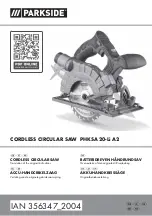
After Sales Support
TEL: 1300 922 271 EMAIL: [email protected]
10
Residual risks
Even if you use this electric power tool in accordance with
instructions, certain residual risks cannot be rules out.
The following hazards may arise in connection with the
equipment’s construction and layout:
1. Lung damage if no suitable protective dust mask is used.
2. Damage to hearing if no suitable ear protection is used.
6. Before starting the equipment
6.1 General information
• All covers and safety devices have to be properly fitted
before the machine is switched on.
• It must be possible for the blade to run freely.
• When working with wood that has been processed before,
watch out for foreign bodies such as nails or screws etc.
• Before you actuate the On/Off switch, make sure that
the saw blade is correctly fitted and that the machine’s
moving parts run smoothly.
• Before you connect the machine to the power supply,
make sure the data on the rating plate is the same as that
for your mains.
6.2 Mounting the saw on a workbench (Fig. 2)
1. It is better to mount the saw on a solid wood workbench
rather than on a weak plywood stand where vibrations
and noise are certain to be a nuisance.
2. The tools and hardware needed to mount the saw on a
work bench are not supplied with the saw. Be sure to use
equipment of at least the following size:
Item Quantity
Hex screws M8 ___________________________________4
Gaskets Ø 8 mm __________________________________4
Washers Ø 8 mm __________________________________4
Hex nuts M8 _____________________________________8
3. A sound-absorbing foam rubber mat is not supplied with
the saw. It is strongly recommended to use such a mat,
however, in order to minimize vibrations and noise.
Do not overtighten the screws. Leave enough scope for the
foam rubber mat to develop a good absorbing effect.
Mounting the saw on a workbench, see Figure (2).
List of components in the illustration:
A: Saw body
B: Foam rubber support
C: Worktable
D: Flat gasket
E: Washer
F: Hex nut
G: Blocking nut
H: Hex screw
6.3 Assembly
Caution! Pull out the power plug before carrying out any
maintenance and conversion work on your fretsaw.
6.3.1 Mounting the saw blade guard and the sawdust
blower facility (Fig. 4/5/6)
• Put the retention bolt (9) on the radial arm (19).
• Slide the saw blade guard (10) onto the retention bolt (9).
• Insert the screw (20) through the bore hole of the
retention bolt (9) and the saw blade guard (10).
• Use the nut (21) to secure the screw from falling out.
• The saw blade guard can be fixed at various heights with
the clamping screw (11).
• Mount the blow-off device (16) as shown in Fig. 6.
6.3.2 Changing the blade (Fig. 1/3/7)
• Turn the clamping screw (14) clockwise in order to take
the tension off the blade (15).
• Unscrew the left cover (4).
• First take the blade out of the top blade holder (13),
pressing down the upper pendulum arm as you do so.
• Then take the blade out of the bottom blade holder (8).
• Pull the blade up and out through the table insert (18).
• Install the new blade in reverse order.
Caution: Always insert the blade so that the teeth point
toward the saw table.
The blade can be inserted in slot a or b;
Slot a: For cuts along the axis of the radial arm.
Slot b: For cuts across the axis of the radial arm.
Tension the blade by turning the clamping screw (14)
anticlockwise (right-hand thread).
6.3.3 Tilting the saw table (Fig. 8)
• Undo the locking screw (5).
• Tilt the table (7) to the left until the indicator (17) points to
the required angle value on the scale (6).
Important: For precision work you should first carry out a
trial cut and then re-adjust the tilt angle as required.
7. Operation
7.1 Please note:
• Your saw does not cut wood automatically. For cutting to
occur, you have to guide the wood against the blade.
• The teeth cut only on the down stroke of the blade.
• You have to guide the wood slowly against the blade
because the teeth are very small.
• Every new user needs a certain training period. You are
certain to break a number of blades at the beginning.
• When cutting thick timber, be particularly careful not to
bend or twist the blade. This will help to prolong blade life.






























